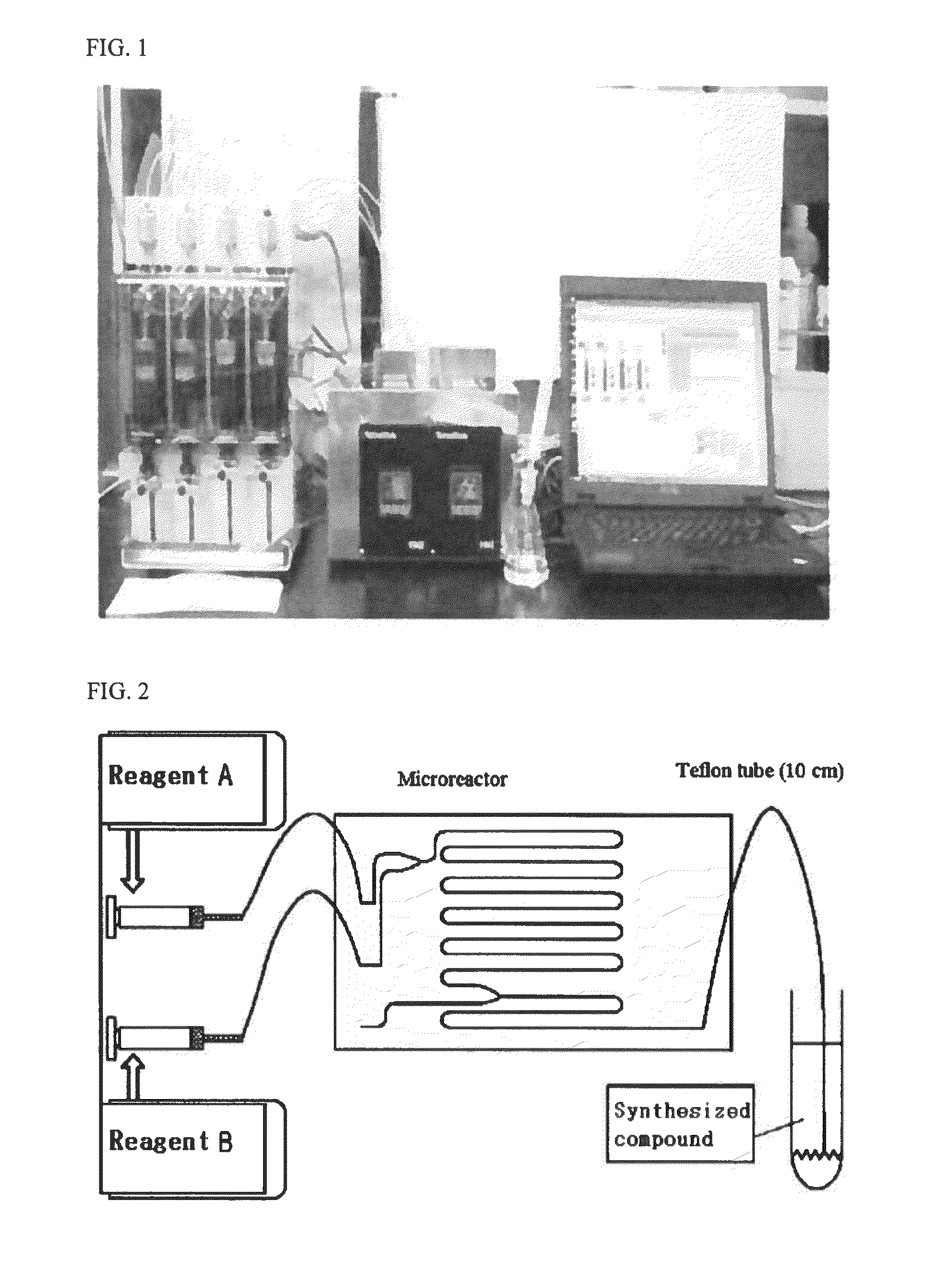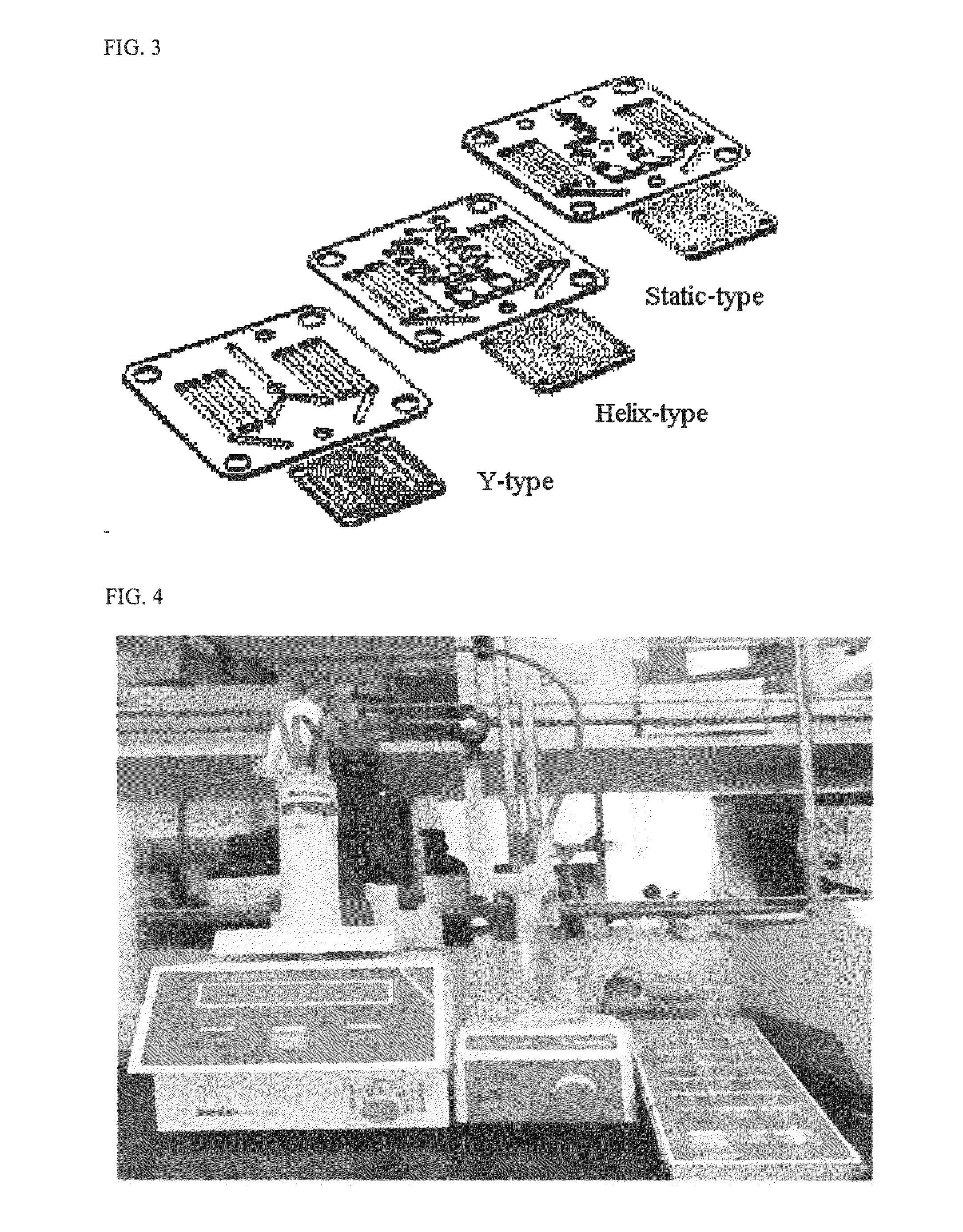Method for preparing ionic liquid having carboxylic acid anion using microreactor
a technology of carboxylic acid anion and microreactor, which is applied in the direction of carboxylic compound preparation, electrochemical generator, amine preparation, etc., can solve the problems of ineffective or economical methods, difficult to mass produce ionic liquids, and cost-consuming conventional methods for preparing ionic liquids by using alkyl halide, etc., to achieve short time for anion substitution reaction, shorten time for substitution reaction, and maximize efficiency
- Summary
- Abstract
- Description
- Claims
- Application Information
AI Technical Summary
Benefits of technology
Problems solved by technology
Method used
Image
Examples
example
Example 1
Synthesis of 1-butyl-3-methylimidazolium butanoate
[0023]5.0 g of 1-butyl-3-methylimidazolium chloride (0.028 mol) was dissolved in 10 g water and then allowed to flow to a microreactor adjusted at 40° C. through a cylinder pump at a flow rate of 300 μl / min. 3.78 g of sodium butanoate (0.034 mol) was dissolved in 10 g of water and then allowed to flow to a microreactor adjusted at 40° C. through a cylinder pump at a flow rate of 281 μl / min. The solutions that passed through the microreactor were collected and then concentrated under reduced pressure to give 6.15 g 1-butyl-3-methylimidazolium butanoate as a pale white solid (97%). The analysis result of the obtained ionic liquid was as follows:
[0024]1H-NMR (DMSO, 400 MHz) δ: 7.32 (d, 1H), 7.28 (d, 1H), 4.03 (t, 2H), 3.74 (s, 3H), 1.99 (t, 2H), 1.68 (q, 2H), 1.14 (t, 3H), 0.73 (t, 3H), residual halide: 5 ppm, electrical conductivity (2.5° C.): 1.187 mS / cm, thermal stability (TGA): 247° C.
example 2
Synthesis of 1,2-dimethyl-3-butylimidazolium butanoate
[0025]5.0 g of 1,2-dimethyl-3-butylimidazolium iodide (0.018 mol) was dissolved in 20 g of water and then allowed to flow to a microreactor adjusted at 40° C. through a cylinder pump at a flow rate of 300 μl / min. 2.13 g sodium butanoate (0.021 mol) was dissolved in 20 g of water and then allowed to flow to a microreactor adjusted at 40° C. through a cylinder pump at a flow rate of 288 μl / min. The solutions that passed though the microreactor were collected and then concentrated under reduced pressure to give 4.09 g of 1,2-dimethyl-3-butylimidazolium butanoate as a while solid (94%). The analysis result of the obtained ionic liquid was as follows:
[0026]1H-NMR (DMSO, 400MHz) δ: 7.61 (d, 1H), 7.59 (d, 1H), 4.07 (m, 2H), 3.71 (s, 3H), 2.60 (s, 3H), 2.35 (s, 2H), 1.66 (t, 2H), 1.64 (t, 2H), 1.23 (q, 2H), 1.21 (q, 2H), 1.21, 0.84 (t, 32H), 0.77 (t, 3H), residual halide: 3 ppm, electrical conductivity (25° C.): 2.032 mS / cm, thermal stab...
example 3
Synthesis of 1,1-butylmethylpyrrolidinium butanoate
[0027]2.0 g of 1,1-butylmethylpyrrolidinium bromide (0.009 mol) was dissolved in 20 g of water and then allowed to flow to a microreactor adjusted at 40° C. through a cylinder pump at a flow rate of 300 μl / min. 1.14 g of sodium butanoate (0.010 mol) was dissolved in 20 g of water and then allowed to flow to a microreactor adjusted at 40° C. through a cylinder pump at a flow rate of 297 μl / min. The solutions that passed through the microreactor were collected and then concentrated under reduced pressure to give 1.78 g of 1,1-butylmethylpyrrolidinium butanoate as a white solid (97%). The analysis result of the obtained ionic liquid was as follows:
[0028]1H-NMR (DMSO, 400 MHz) δ: 4.63 (s, 2H), 3.37 (m, 2H), 3.18 (m, 2H), 2.91 (s, 2H), 2.08 (t, 2H), 2.00 (t, 2H), 1.42 (m, 3H), 1.30 (s, 2H), 1.24 (s, 2H), 0.81 (t, 3H), 0.75 (t, 3H), residual halide: 1 ppm, electrical conductivity (250° C.): 1.156 mS / cm, thermal stability (TGA): 243° C.
PUM
| Property | Measurement | Unit |
|---|---|---|
| reaction time | aaaaa | aaaaa |
| time | aaaaa | aaaaa |
| flow rate | aaaaa | aaaaa |
Abstract
Description
Claims
Application Information
 Login to View More
Login to View More - R&D
- Intellectual Property
- Life Sciences
- Materials
- Tech Scout
- Unparalleled Data Quality
- Higher Quality Content
- 60% Fewer Hallucinations
Browse by: Latest US Patents, China's latest patents, Technical Efficacy Thesaurus, Application Domain, Technology Topic, Popular Technical Reports.
© 2025 PatSnap. All rights reserved.Legal|Privacy policy|Modern Slavery Act Transparency Statement|Sitemap|About US| Contact US: help@patsnap.com



